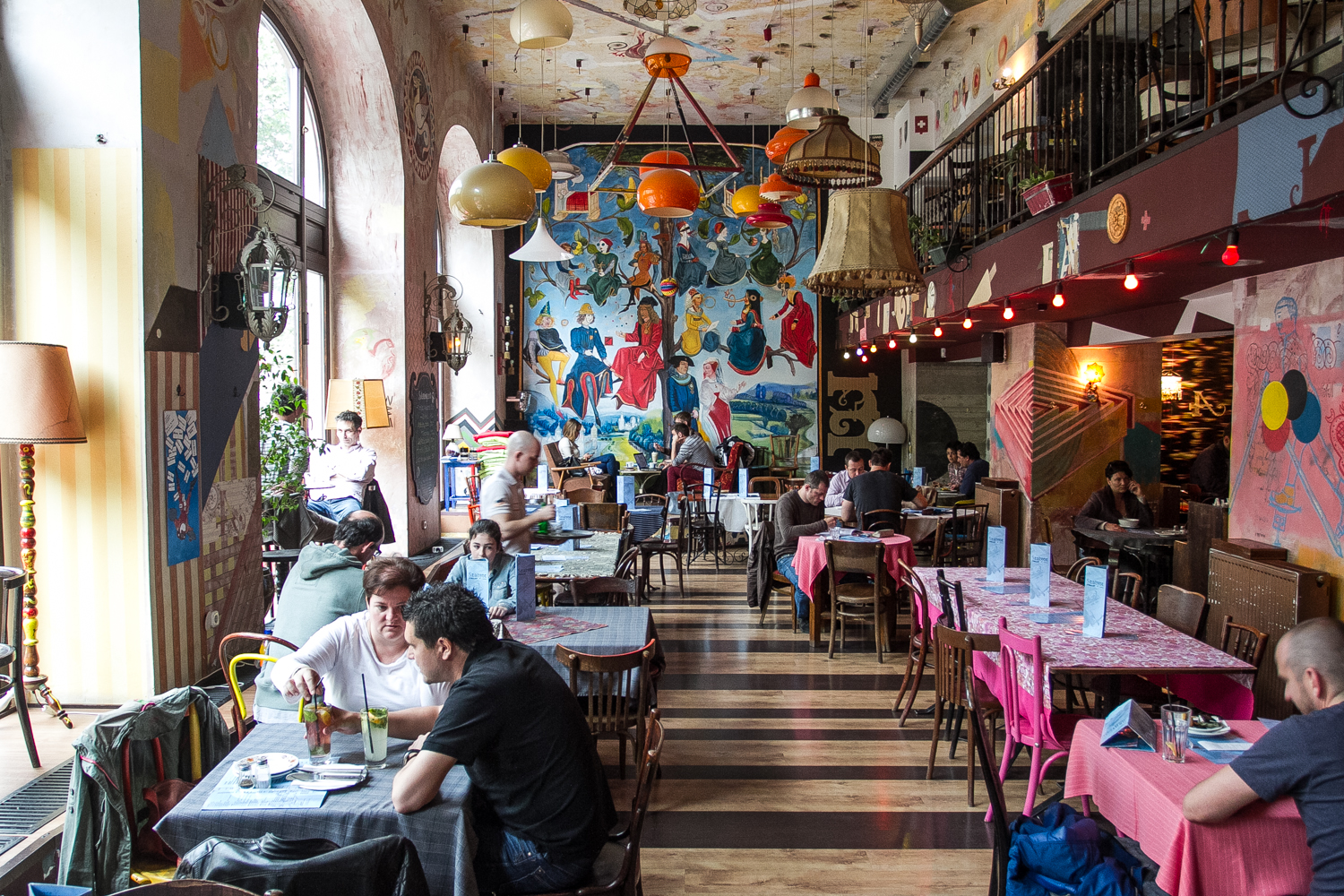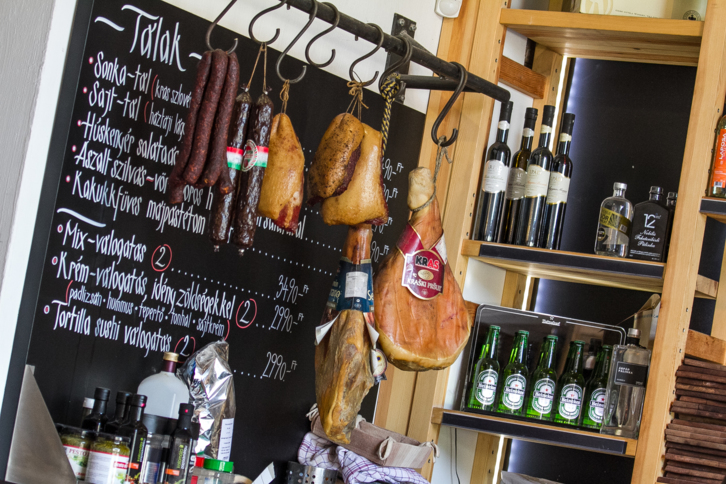Despite being named after Hungary's greatest musician of the 20th century, Bartók Béla Avenue was once an unsung street of Buda's District XI, particularly the part between St. Gellért Square and Móricz Zsigmond Square. Its tree-lined glory was finally recognized a few years ago with a transformation into an artsy cult street loaded with loft cafés and exhibition spaces. The metamorphosis was not easy, but now we can say that the project is a success: small galleries open one after the other here, and we can expect pleasant surprises regarding gastronomical experiences, too.
1/1
We began our walk at St. Gellért Square, overlooking the Danube. Whether we arrive by metro, tram, bus, or riverboat, Palack Borbár is always a good choice if we would like to drop by for a quick glass of wine or a fröccs (Hungary's variably potent version of spritzers). The selection includes about 80-100 wines, with a focus on smaller wineries that only produce high-quality libations.
The recommendations of sommelier Gábor Petrányi are worth considering, since the wines of Szilárd Nádas (Etyek-Buda), the Feiszt Winery (Szekszárd), the Pelle Family Estate (Tokaj), or the Csóbor Winery (Agárd) are relatively unknown but all excellent in different ways. Palack is especially good for long conversations: for side dishes accompanying the wine, we can choose among platters of tapas, hams, and cheeses, with the latter hailing from the Nárcisz Cheese Workshop, while the matured smoked hams are from Biatorbágy. Don't miss the specialty red-wine flavored wild-deer sausages.
A special attraction of Palack is that it is located in the same building as the Próféta Gallery, offering quality exhibitions and named after the pub and restaurant that used to operate there. For wine-tasting occasions, the gallery is open so that we can sip among contemporary works amid a pleasantly spacious environment.
In the surrounding area, two other places offer pleasant beer-drinking settings: along Kemenes Street, Pagony settled into the site where the Gellért Spa's children's pools used to be, while Budafoki Street is the home of Libella, the favorite haunt of many art students. However, we are still progressing along Bartók Avenue, and our next stop is Moha, defined as a global art exhibition space. In addition to the usual coffee and gastro selection, here we enjoy jazz concerts, literary evenings, the historical cinematic rarities of the Godot Film Club, live piano, and a charming green wall.
Across the road lies a creative public institution dating back roughly eight years, Defo Labor: here we find an atelier atmosphere, a design shop, and fresh coffee aromas. In addition to innovative products by international and Hungarian designers, we can also buy selected books about contemporary style. Defo is also a workplace, organized mostly to facilitate group projects. Occasionally they also host workshops and various design-related events in the shop.
The boulevard's centerpiece is a nice little pocket park, Gárdonyi Square, which was renovated a few years ago. In the middle is a sculpture of the square's eponymous historical novelist, along with a fountain and ornamental lights.
The preferred hangout of noted Magyar wordsmith Frigyes Karinthy, Hadik Café reopened a few years ago and is ever-popular, not only because of the nostalgic interior, but also because of the consistently fine cuisine and delicious cakes. Now the street in front of the café overlooking the square has been turned into a pedestrian zone, so we can enjoy the carillon of the opposing school from the huge terrace, or lounge on the new benches as well.
The city's most recognized contemporary gallery is located nearby here, but was found on Ráday Street in District IX for a long time. After a name change the Faur Zsófi Gallery moved its headquarters to Bartók Béla Avenue into a site that was renovated in an exemplary manner, and the exhibitions shown here are among the city's best.
On the opposite side of the square is the Palmetta Design Gallery, founded by textile artist Anna Regős and painter István Regős about 15 years ago in Szentendre. Their goal is to introduce products by contemporary international designers to the Hungarian public, but there is also a place for goods by local artisans on the shelves. A high level of awareness defines the gallery, since the sleek handmade merchandise is never accompanied by tourist-favorite junk that counts as a bestseller at places of lesser quality.
Nearby we find a miniature café (compared to Hadik and the adjacent Szatyor pub) that is also a locals' secret: Gdansk. Upon entering, patrons find a familiar atmosphere, craft beer, Polish vodka, and marinated herring, all accompanied by Polish and Hungarian literature because this place is also a bookstore.
The Kelet Café and Gallery is not a bookstore, but even a small library would be envious of the thousands of volumes lining the walls here. The shelves look good, but decoration is not their only function - whoever brings a book to exchange can take one of the volumes from the café, so the literary selection is different every day. However, this is not the only reason to visit - the coffee is supplied by Casino Mocca, the Dutch premium cocoa by Tibor Szántó, the cakes by Sári Édes, and the beers are made by two small Czech breweries. Even this is not everything: try the grilled sandwiches and Eastern foods inspired by Dutch chef Tom, who acts as a consultant for the place.
As for the Eastern foods, we can try green-curry Liptauer, spicy peanut butter, chutney, Indonesian pickles, and sourdough bread; simply writing about the sandwiches makes us hungry: spicy Indonesian peanut butter, egg-curry masala, smoked catfish, coriander sauce, ruccola… the list goes on. The place also has a pleasant interior design, the service and owners are friendly, and the selection is simply excellent.
The Figaro magic shop is definitely worth a visit: the staff even makes the change disappear, then somehow pulls it out of their other jacket sleeve. This place is very fun; we were amazed and entertained at the same time. The institution has been operating for so long that it is practically 'the' magic shop of Budapest ever since 1969. Its founder was magician István Szabó, who worked as a barber before opening the shop, hence the name. Figaro is a place where the staff tries its very best to dazzle us with every visit.
Next to the shop is the Zipernowsky Hall of Arts and Sciences. As its name implies, this 'mini community center' occasionally hosts science and art exhibitions, but more importantly, lots of programs for children are organized here. They hold lively educational lectures and conduct experiments that get even the most bored children excited. In addition to these lectures, arts and crafts programs and the maternity club are also popular among locals.
It is nearly impossible to forget the opening dates of exhibits at the Három Hét Gallery, since the vernissages are on the 3rd of every month at 7pm. Previously this place operated as a photo gallery, but after a recent change of concept the exhibitions mostly promote environmental awareness and sustainability. They offer workshops regularly with a goal to form a community.
A genuine community institution, Szalay Fotó, has operated at 37 Bartók Béla Avenue for 72 years now. As we step in, we are welcomed with antique equipment, brown-tinged images, and ancient cameras - and, of course, Ágnes Szalay, whose father Béla Szalay founded the store in 1942.
Almost everyone in the family worked in the field of photography, but as the owner points out, it is not the kind of profession that most can make a living from. Long ago there was a constant need for ID pictures, but recently they receive less and less customers - even though in the past their clientele included many local celebrities. Despite this illustrious past, Ágnes Szalay will close the business and retire in two years, and the old equipment will be sent to a museum. Among these things is a handmade wooden photography machine that was still used for taking portraits until 2010.
Csabi Íz opened just a few weeks ago, but customers are already lining up to get into this hotspot for sandwiches and salads. We cannot imagine more toppings on the premium sandwiches: ham, salami, cheese, eggs, tomatoes, cucumbers, etc., and the potato salad was the neighborhood's favorite even when Csaba Suri was the chef of a restaurant on Gellért Hill. Everything is clean and tidy here, and food is prepared freshly right in front of the guests' eyes. It is worth visiting for breakfast or even lunch, and the daily menu is available at a surprisingly good price-quality ratio.
Finally, before we reach Móricz Zsigmond Square and the renovated Gomba, we wanted to try Limone Gelato's ice cream. They make the creamy frozen treat themselves, and what they are really proud of is the elderberry yogurt, and the pistachio-flavored 'forest master'.





